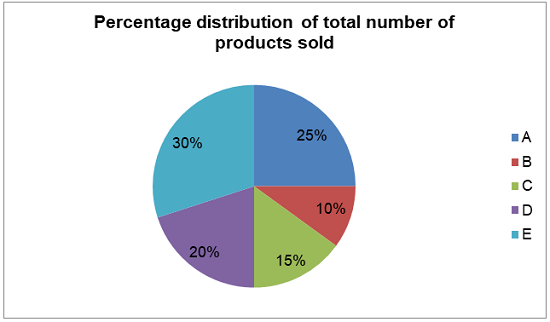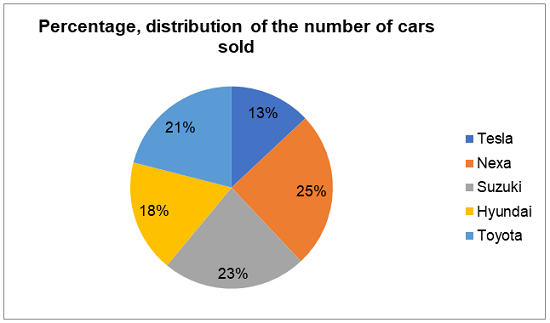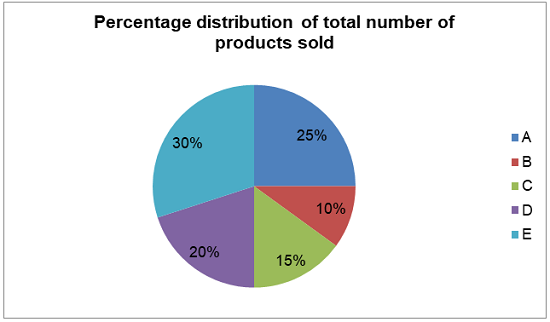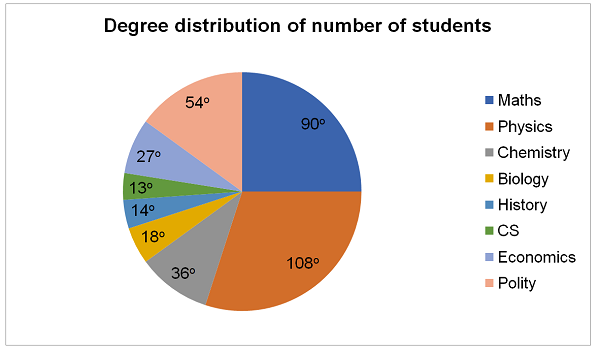Pie Chart For SSC CGL: A Pie Chart is one of the topics under the SSC CGL Quantitative Aptitude section. The Pie Chart For SSC CGL Quantitative Aptitude section consists of 4-6 questions weightage and the level of questions appears in easy to moderate form. Candidates can find the questions related to the Pie Chart For SSC CGL, which we have provided in both Hindi and English language at the candidate’s convenience. The questions that we have provided in the blog, are the recommended questions with the help of experts and by analyzing the previous year’s question paper. The SSC can present the different types of questions in the exams on a Pie Chart, so the candidates must solve the questions on different patterns to avoid mistakes in the Pie Chart For SSC CGL topic.
Pie Chart For SSC CGL Explanation
A Pie Chart DI can be explained as it is a type of chart that is represented in the form of a circle. The circle is further divided into slices to represent the numerical proportion. Each numerical portion or segment is proportional to the quantity it represents.
Pie Chart Important Formulas
There are two main formulas related to the Pie Chart provided below, candidates are advised to note them down in their formula notes for revision purposes during the last days of the exam.
Formulas:
1. To Draw a Pie Chart with a central angle:

2. To Draw a Pie Chart with Percentages

Representation of Pie Chart
Here we have provided a Pie Chart diagram that how actually it looks likes.

Important Questions on Pie Chart with Solutions
Candidates can find the questions in this section. As for the candidate’s convenience, we have provided the questions in both Hindi and English languages with their solutions provided with explanations. Candidates are advised to try to solve the questions first and then see the explanations to analyze their preparation level on the topic.
Pie Chart Questions in the English Language
Question 1: The given pie chart shows the percentage distribution of five different types of products sold.

The number of product ‘D’ sold is how much percent more/less than the number of product ‘A’ sold?
A) 25%
B) 15%
C) 20%
D) 30%
Question 2: The given pie-chart shows the percentage distribution of number of cars sold of five different brands. The total number of cars of all the five brands sold is 24000.

Find the sum of the number of Nexa’s cars sold and Toyota’s cars sold.
A) 10150
B) 13050
C) 12040
D) 11040
Question 3: The given pie-chart shows the percentage distribution of number of cars sold of five different brands. The total number of cars of all the five brands sold is 24000.

The number of Toyota’s cars sold is how much percent more/less than that of Hyundai’s cars?
A) 16.66%
B) 8.33%
C) 14.24%
D) 12.33%
Question 4: The given pie-chart shows the percentage distribution of number of cars sold of five different brands. The total number of cars of all the five brands sold is 24000.

The difference between the number of Suzuki’s car sold and Hyundai’s cars sold is same as the difference of number of cars sold of
A) Tesla and Toyota
B) Suzuki and Nexa
C) Hyundai and Tesla
D) Nexa and Toyota
Question 5: The given pie-chart shows the percentage distribution of number of cars sold of five different brands. The total number of cars of all the five brands sold is 24000.

Find the difference between the number of number Tesla’s cars sold and Toyota’s cars sold.
A) 2460
B) 1920
C) 1580
D) 1420
Question 6: The given pie-chart shows the degree distribution of number of students who like different subjects.

The number of students who like Maths exceeds the number of students who like Economics and Biology together by
A) 30%
B) 15%
C) 25%
D) 12.5%
Question 7: The given pie chart shows the percentage distribution of number of students in five different schools.

The number of students in school ‘D’ is how much percent more/less than the number of students in school ‘A’?
A) 25%
B) 15%
C) 20%
D) 30%
Question 8: The given pie-chart shows the degree distribution of number of students who like different subjects.

If the number of students who like Polity is 108, then find the number of students who like Chemistry.
A) 84
B) 56
C) 66
D) 72
Question 9: The given pie-chart shows the degree distribution of number of students who like different subjects.

What percent of students like Biology, History and CS together?
A) 12.5%
B) 15%
C) 10%
D) 18.5%
Question 10: The given pie-chart shows the degree distribution of number of students who like different subjects.

If total number of students is 2400, then find the average number of students who like Maths, Physics and Polity.
A) 580
B) 640
C) 560
D) 480
Pie Chart Questions in the Hindi Language
प्रश्न 1: दिए गए pie chart पांच अलग-अलग types के products के प्रतिशत वितरण को दर्शाता है।

बेचे गए product ‘D’ की संख्या, बेचे गए product ‘A’ के संख्या से कितने प्रतिशत अधिक / कम है?
A) 25%
B) 15%
C) 20%
D) 30%
प्रश्न 2: दिए गए pie-chart पांच अलग-अलग brands की बेची गयी कारों की संख्या का प्रतिशत वितरण दर्शाता है। बेची गयी सभी पांच brands की कारों की कुल संख्या 24000 है।

बेची गई Nexa की कारों की संख्या और बेची गई Toyota की कारों की संख्या का योग ज्ञात करें?
A) 10150
B) 13050
C) 12040
D) 11040
प्रश्न 3: दिए गए pie-chart पांच अलग-अलग brands की बेची गयी कारों की संख्या का प्रतिशत वितरण दर्शाता है। बेची गयी सभी पांच brands की कारों की कुल संख्या 24000 है।

बेची गयी Toyota की कारों की संख्या Hyundai की कारों की तुलना में कितने प्रतिशत अधिक / कम है?
A) 16.66%
B) 8.33%
C) 14.24%
D) 12.33%
प्रश्न 4: दिए गए pie-chart पांच अलग-अलग brands की बेची गयी कारों की संख्या का प्रतिशत वितरण दर्शाता है। बेची गयी सभी पांच brands की कारों की कुल संख्या 24000 है।

बेची गयी Suzuki कार और बेची गयी Hyundai की कारों की संख्या के बीच का अंतर निम्नलिखित में से किस कारों की बिक्री के बीच के अंतर के समान है?
A) Tesla और Toyota
B) Suzuki और Nexa
C) Hyundai और Tesla
D) Nexa और Toyota
प्रश्न 5: दिए गए pie-chart पांच अलग-अलग brands की बेची गयी कारों की संख्या का प्रतिशत वितरण दर्शाता है। बेची गयी सभी पांच brands की कारों की कुल संख्या 24000 है।

बेची गई Tesla कारों की संख्या और बेची गई Toyota’s कारों के बीच का अंतर ज्ञात करें?
A) 2460
B) 1920
C) 1580
D) 1420
प्रश्न 6: दिए गए pie-chart विभिन्न विषयों को पसंद करने वाले छात्रों की संख्या के वितरण को दर्शाता है।

Maths पसंद करने वाले छात्रों की संख्या उन छात्रों की संख्या से कितनी अधिक है जो Economics और Biology दोनों को पसंद करते हैं?
A) 30%
B) 15%
C) 25%
D) 12.5%
प्रश्न 7: दिए गए pie chart पांच अलग-अलग schools में छात्रों की संख्या के प्रतिशत वितरण को दर्शाता है।

School ‘D’ में छात्रों की संख्या school ‘A’ में छात्रों की संख्या से कितने प्रतिशत अधिक / कम है?
A) 25%
B) 15%
C) 20%
D) 30%
प्रश्न 8: दिए गए pie-chart विभिन्न विषयों को पसंद करने वाले छात्रों की संख्या के वितरण को दर्शाता है।

यदि Polity को पसंद करने वाले छात्रों की संख्या 108 है, तो Chemistry पसंद करने वाले छात्रों की संख्या ज्ञात करें?
A) 84
B) 56
C) 66
D) 72
प्रश्न 9: दिए गए pie-chart विभिन्न विषयों को पसंद करने वाले छात्रों की संख्या के वितरण को दर्शाता है।

Biology, History और CS पसंद करने वाले कितने प्रतिशत छात्र हैं?
A) 12.5%
B) 15%
C) 10%
D) 18.5%
प्रश्न 10: दिए गए pie-chart विभिन्न विषयों को पसंद करने वाले छात्रों की संख्या के वितरण को दर्शाता है।

यदि छात्रों की कुल संख्या 2400 है, तो Maths, Physics और Polity पसंद करने वाले छात्रों की औसत संख्या ज्ञात करें?
A) 580
B) 640
C) 560
D) 480
Solutions of the Above Questions with Explanation
Solution 1: C)
Required percentage = {(25 – 20)/25} × 100 = 20%
Hence, option c.
Solution 2: D)
Required sum = (0.25 × 24000) + (0.21 × 24000) = 6000 + 5040 = 11040
Hence, option d.
Solution 3: A)
Required percentage = {(21 – 18)/18} × 100 = 16.66%
Hence, option a.
Solution 4: C)
Difference between the number of Suzuki’s cars sold and Hyundai’s cars sold = (23 – 18)% of 24000 = 1200
Difference between the number of Hyundai’s cars sold and Tesla’s cars sold = (18 – 13)% of 24000 = 1200
Hence, option c.
Solution 5: B)
Required difference = (21 – 13)% of 24000 = 1920
Hence, option b.
Solution 6: D)
Required percentage = {900 – (18o + 27o)} × 100/360o = 12.5%
Hence, option d.
Solution 7: C)
Required percentage = {(25 – 20)/25} × 100 = 20%
Hence, option c.
Solution 8: D)
Required number of students = {(108/54) × 36 = 72
Hence, option d.
Solution 9: A)
Required percentage = {(18o + 14o + 13o)/360o} × 100 = 12.5%
Hence, option a.
Solution 10: C)
Required average = [{(90o + 108o + 54o)/360o} × 2400] ÷ 3 = 560
Hence, option c.
Pie Chart For SSC CGL FAQs
Yes, the level of the Pie Chart for SSC CGL is easy to moderate.
Candidates can expect 4-6 questions on the Pie Chart for SSC CGL.
A Pie Chart can be defined as it is the representation of data in a circular form, more details are provided in the blog.
You can find the Pie Chart questions in the above blog.
- Sign Up on Practicemock for Updated Current Affairs, Free Topic Tests and Free Mini Mocks
- Sign Up Here to Download Free Study Material
Free Mock Tests for the Upcoming Exams
- IBPS PO Free Mock Test 2024
- RBI Grade B Free Mock Test 2024
- IBPS SO Free Mock Test 2024
- NABARD Grade A Free Mock Test 2024
- SSC CGL Free Mock Test 2024
- IBPS Clerk Free Mock Test 2024
- IBPS RRB PO Free Mock Test 2024
- IBPS RRB Clerk Free Mock Test 2024
- RRB NTPC Free Mock Test 2024
- SSC MTS Free Mock Test 2024
- SSC Strenographer Free Mock Test 2024
- GATE Mechanical Free Mock Test 2024
- GATE Civil Free Mock Test 2024
- RRB ALP Free Mock Test 2024
- SSC CPO Free Mock Test 2024
- AFCAT Free Mock Test 2024
- SEBI Grade A Free Mock Test 2024
- IFSCA Grade A Free Mock Test 2024
- RRB JE Free Mock Test 2024
- Free Banking Live Test
- Free SSC Live Test



